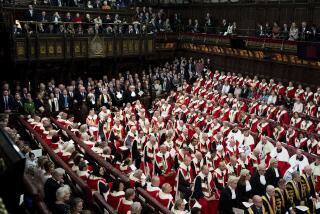Peerages are Mostly Hereditary and Consist of 5 Ranks Created by Crown
- Share via
The British nobility, or peerage, consists of five ranks created by the Crown. They are, in descending order, duke, marquess, earl, viscount and baron, or, in the case of women, duchess, marchioness, countess, viscountess and baroness. One of the privileges of nobility is sitting in the House of Lords.
Peerages are for the most part hereditary, passing from father to eldest son, although provision has been made in special cases for the title to pass to a daughter if the male line should fail.
Under the Life Peerages Act of 1958, the monarch may appoint peers whose titles expire with their death. Other non-hereditary members of the chamber are bishops of the Anglican Church and, since early this year, the chief rabbi of Britain.
As in the House of Commons, members associated with the Conservative Party are seated on one side of the chamber and members associated with the Labor Party on the other. Independent members sit where they please.
Senior members--in the case of the party in power, Cabinet members or those representing a particular government department in the chamber--sit in the front row; junior members, with no special responsibilities, toward the back. From this has grown the practice of referring to Cabinet officers as front-benchers and the rest of a party’s members in the chamber as back-benchers.
More to Read
Sign up for Essential California
The most important California stories and recommendations in your inbox every morning.
You may occasionally receive promotional content from the Los Angeles Times.











